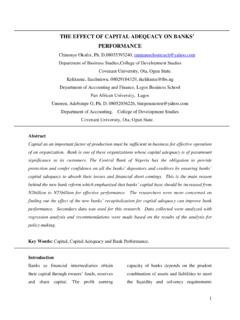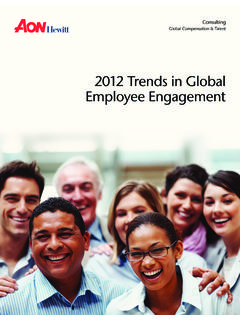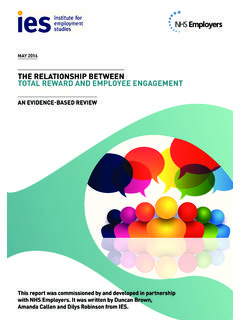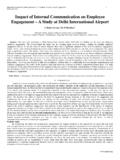Transcription of EFFECT OF EMPLOYEE ENGAGEMENT ON …
1 Countries such as China and India are experiencing skill shortages in many fields. The workforces in these The business environment around is full of trials and countries frequently show the desire and ambition to get many executives are facing an acute challenge of making ahead that contrasts with their counterparts. the people changes that they feel are necessary to rapidly Research by consultancy DDI shows that employees in improve performance whilst maintaining EMPLOYEE China are more satisfied than their counterparts ENGAGEMENT . The success of organizations in a changing with their work life balance. They are more willing to economy is tied in large measure to the creative and make personal sacrifices; they have stronger desire for innovative energy from the most significant asset: promotion and find work more fulfilling than their employees. When employees are effectively and personal life. Conversely, workers in China were twice positively engaged with their organization, they form an less likely to agree with the statement I have too much to emotional connection with the company.
2 This impacts do than their counterparts. So while their attitude towards the company s clients, and thereby employees are striving for balance and are fairly cautious improves customer satisfaction and service levels. about making personal sacrifices to advance their Successful EMPLOYEE ENGAGEMENT helps create a careers, their Chinese counterparts have a thirst for community at the workplace and not just a , new knowledge and and Brazil have young and plentiful growing According to Sarah Cook (2008), as economies develop workforces; China has one of the world s largest but and there is more choice of employment, organizations oldest populations. Retention issues are already will find it increasingly challenging to attract and retain beginning to emerge in these countries with workers talent and potential. In order to harness the ambition of quick to leave for better remuneration and higher job EFFECT OF EMPLOYEE ENGAGEMENT ON ATTRITION WITH RESPECT TO SERVICE INDUSTRYDr.
3 Rabiya T. S. Sange, Assistant Professor, Human Resources,Allana Institute of Management Studies, As economies develop and there is more choice of employment, organizations will find it increasingly challenging to attract and retain talent and potential. This change in economic conditions would mean being less dependent on manufacturing markets and more focused on service industries. This increases the importance of employees becoming brand ambassadors. In a race to survive in a highly competitive service industry, most organizations realize that a satisfied EMPLOYEE does not necessarily mean a loyal EMPLOYEE and a high performer. Moreover, in times of diminishing loyalty, EMPLOYEE ENGAGEMENT is a powerful retention strategy. The fact that it has a strong impact on the bottom line adds to its significance, thus making EMPLOYEE ENGAGEMENT an essential tool in managing human capital (Sarah Cook, 2008).Objective: The research paper aims at investigating the EFFECT of EMPLOYEE ENGAGEMENT on attrition in organizations with special reference to service : Secondary data sources were used to understand the existing literature on the topic.
4 Survey, personal and telephonic interviews were used to gather data from primary sources. HR professionals of 64 organizations from the service industry were : Correlation and Regression analysis was applied to the dataset using SPSS 15. The Hypothesis EMPLOYEE ENGAGEMENT practices significantly affect EMPLOYEE attrition was accepted at level of : It was found that EMPLOYEE ENGAGEMENT strategies do have a significant EFFECT on reducing the attrition rate in organizations. However, a more serious consideration in exploring the relationship between the two variables needs to be made by the organization to have an impact on bottom line Words: Attrition, Retention, EMPLOYEE ENGAGEMENT , Service Industry, Business EnvironmentBVIMSR s Journal of Management Research 60 Vol. 7 Issue - 1 : April : 2015 BVIMSR s Journal of Management Research 61 Vol. 7 Issue - 1 : April : 2015employees, businesses will need to put in place profitability, EMPLOYEE retention, safety, and programmes for robust recruitment and selection, customer satisfaction (Buckingham & Coffman, ongoing development and succession planning.)
5 For 1999; Coffman & Gonzalez-Molina, 2002). example, Proctor & Gamble has been successful in Similar relationships have not been shown for attracting and retaining high quality managers although most traditional organizational constructs such as the compensation package is not as attractive as job satisfaction (Fisher & Locke, 1992) (Sources elsewhere because they offer continuous learning and quoted by Little, 2006).development to their managers. Businesses that b)The items used in EMPLOYEE ENGAGEMENT surveys thoroughly embrace the concept of EMPLOYEE measure aspects of the workplace that are under ENGAGEMENT will carve a clear competitive advantage for the control of the local manager. (Little, 2006)themselves in the ENGAGEMENT became a topic of concern in early 2000 when the dotcom bubble burst, 9/11 occurred, REVIEWthe economy dipped, and unemployment rose. At that time, the common response from managers to employees EMPLOYEE ENGAGEMENT Evolution & Conceptwas, You should be happy you have a job.
6 Work ENGAGEMENT at work was conceptualized by Kahn, expectations rose, while companies froze employees (1990) as the harnessing of organizational members pay. The result was a disengaged workforce. Employees selves to their work roles . In ENGAGEMENT , people had been put through so much that when the economic employ and express themselves physically, cognitively, conditions improved they realized that they have choices and emotionally during role This caused immense pain to employers who The term EMPLOYEE ENGAGEMENT , in its present usage, were afraid of losing them. Employers then started doing was coined by the Gallup Organization, as a result of 25 ENGAGEMENT surveys, ENGAGEMENT studies, and years of interviewing and surveying employees and ENGAGEMENT workshops to develop ENGAGEMENT managers. Their intent was to create a measure of strategies. (Ketter, 2008)workplaces that could be used for comparisons. Although the term EMPLOYEE ENGAGEMENT has become a According to Buckingham & Coffman (1999), Gallup buzzword, it is used quite inconsistently by research spent years refining a set of EMPLOYEE opinion questions institutes, corporate houses and consulting firms.
7 It is that are related to organizational outcomes. The also used to refer to a number of EMPLOYEE attitudes like statistically derived items, called the Gallup Workplace satisfaction, motivation, commitment etc. Most of the Audit (GWA) that measure EMPLOYEE ENGAGEMENT are literature employs a multidimensional approach to related to productivity, profitability, EMPLOYEE retention defining EMPLOYEE ENGAGEMENT , where the definition and customer service at the business unit level (hospital, encapsulates several elements required in order to hotel, factory, etc.). They report that employees who achieve true ENGAGEMENT . As a result there has been score high on the questions are "emotionally engaged" in extreme confusion with regards to the work and the organization (Sources quoted by Little, A variety of definitions have been put forth leading to 2006).lack of clarity and understanding about what ENGAGEMENT Melcrum Publishing (2005) found that from a global is all about.
8 For the purpose of the research paper, survey of over 1,000 communication and HR EMPLOYEE ENGAGEMENT is defined as A positive attitude practitioners 74% began to formally focus on the issue held by the EMPLOYEE towards the organisation and its between 2000 and An engaged EMPLOYEE is aware of business The term has shown up in Workforce Magazine (2005), context and works with colleagues to improve Harvard Business Review (2005) and the Washington performance within the job for the benefit of the Post (2005), not to mention the websites of many Human organisation. The organisation must work to develop and Resources consulting firms such as DDI (2005) and nurture ENGAGEMENT which requires a two-way Towers Perrin (2003) (Sources quoted by Little, 2006). relationship between employer and EMPLOYEE . The term seems to be attractive for at least two reasons:(Robinson et al., 2004)a) EMPLOYEE ENGAGEMENT has been shown to have a statistical relationship with productivity, EFFECT Of EMPLOYEE ENGAGEMENT On Attrition With Respect To Service IndustryBVIMSR s Journal of Management Research 62 Vol.
9 7 Issue - 1 : April : EMPLOYEE Attritionworldwide, attrition is predicted at in 2013 as compared to in 2010. The number of workers Hiring and EMPLOYEE retention have been identified as expected to take flight in 2014 will increase by as the key challenges in managing and measuring compared with 2012. This is mainly due to increase in EMPLOYEE productivity, according to a survey conducted industry growth and employment opportunities. among more than 200 HR managers across industries. Comparatively, turnover was minimal between 2010 and The Workforce Productivity India 2012 report revealed 2012. In the next five years, 49 million employees will that HR managers are too caught up in fire fighting leave their employers that they are less able to focus on more strategic objectives of their business operations. (The Hindu, (Hay Group, 2013)2012)In India, EMPLOYEE turnover is predicted to rise to Attrition rate has always been a sensitive issue for all in 2013 compared with 26% in 2010.
10 This makes attrition organizations. Calculating EMPLOYEE turnover rate is not rate in India the highest in the world making it a dire that simple as it seems to be. No common formula can be necessity for oorganizations in India must give serious used by all the organizations. A formula has to be devised thought to what drives EMPLOYEE commitment. Firms keeping in view the nature of the business and different need to focus on employees with mission-critical skills, job functions. Moreover, calculating attrition rate is not as well as high-potentials and those holding crucial roles. only about devising a mathematical formula. It also has (Hay Group, 2013)to take into account the root of the problem by going back The India Attrition Study 2008, done between October to the hiring and March 2009, was a partnership between BT and There is no standard formula to calculate the attrition rate People Strong to figure out why employees quit of a company. This is because of certain factors as: (Dev, (published by BT in April 2009).)











